How To Grow Dryland Winter Wheat - 2023 Experiment
Winter Wheat is planted in the fall, harvested in the spring, and can be grown without irrigation. I have not grown wheat before and it will be exciting to learn if it can produce a crop with only spring moisture. There is easily more than 10000 acres of dryland winter wheat grown less than 100 miles south of my location.
I planted LCS-Jet, a non-GMO hard red winter wheat that grows and produces well in Washington State under dryland conditions. By law it is illegal to commercially produce GMO modified wheat in the USA. Seeding rate is 75lbs per acre and a 50lb bag can cover 2/3 of an acre. I bought 50 lbs from McKay Seed in in Almira for $20.00. The Almira location is located on a dirt road a few miles off a 2 lane highway in the middle of miles and miles of wheat fields.
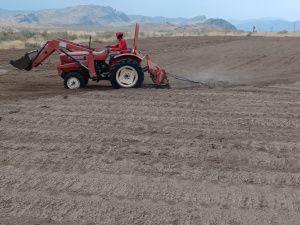

Winter Wheat / Covering Seed / Sep 2023
|
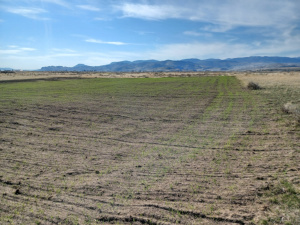
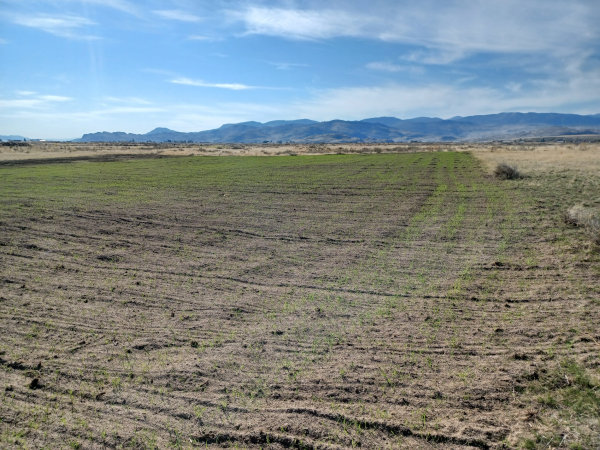
Winter Wheat Sprouting / Oct 08 2023
|
Most recommendations were to add 20lbs of Nitrogen per acre in the fall and then a heavy application in the spring. Also I was planning to use Potassium Sulfate but it turned out to be much more expensive so opted for Murate of Potash which is Potassium Chloride. I bought a 130lb rotary spreader which I was able to attach to the back of the tiller tight enough so it wouldn't dump over. I had to till deeply a second time to remove the washboard ridges to get the spreader to work properly.
The Zinc was a powder and clumpy so I smashed it into smaller pieces and the spreader broke it up reasonably well. The Manganese got wet so we dissolved it in water at about 1lb per 4 gallons and sprayed it on the ground with a backpack sprayer, which took about 12-20 4 gallon tanks. Adjustment of the spreader for powder, pellets, and seed was tricky but when it pours out the bottom, adjust, pick it up, throw it back in the spreader with the dirt, and keep going.
We added the 1152 and Urea last, tilled everything in, spread the seeds, and dragged the field with the rebar harrow upside down. I actually tilled more than 2/3 of an acre so actually used 100lbs of 1152, and planted only 3/4 of the tilled area reserving the lowest area for corn next spring (part of this is visible in the right picture above at upper middle left the dark brown area).
Planting time should be September or October latest. There was 0.8 inches of raid on Sep 20th and we planted on Sep 24th 2023. I was concerned about dust but the timing was perfect. As we were finishing dragging the field it was sprinkling lightly and it rained intermittently the next few days. Now on Oct 6 2023 the wheat is sprouting in the area planted and from a distance looks like a green fuzz on the field.
Winter Wheat (Starter) Fall Fertilizer For 2/3 Acre
We tilled and fertilized a larger area so I used 100 lbs of KCL and 100 lbs of 1152 and left the extra area for spring corn planting. The 1152 has some Nitrogen and actually added 15 lbs of urea since that's what was left in an already open bag.
| 20 lbs Urea 46-0-0 | N 13.8 lbs/acre |
| 90 lbs 1152 11-52-0 | N 15 lbs/acre + P205 70 lbs/acre |
| 77 lbs KCl MOP 0-0-60 | K2O 70lbs/acre |
| 35 lbs FeSO4 31% Iron Monohydrate | Iron 16 lbs/acre |
| 30 lbs Zinc Sulfate 35% Zinc | Zinc 10 lbs/acre |
| 30 lbs MgO 45% Magnesium Oxide | Magnesium 20 lbs/acre |
| 12 lbs MnSO4 28% | Manganese 5 lbs/acre |
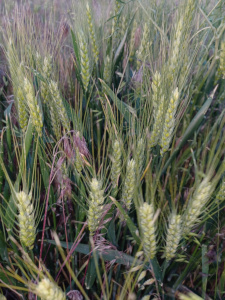
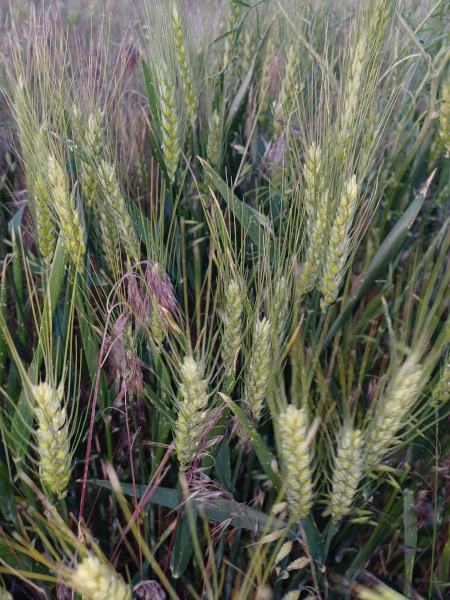
Winter Wheat - Update 2024
I did not add fertilizer in the spring and by harvest time the cheatgrass was about the same height as the wheat. The wheat did produce well, and in one area where we had spilled extra fertilizer the wheat was taller than the cheatgrass and had larger spikes and kernels.
Comparing Corn and Winter Wheat
With a lack of irrigation and summer rainfall, it is easier to get a good yield of wheat compared to corn. There are hundreds of acres of wheat planted 60 miles southeast of my location (and no unirrigated corn). If planting more than an acre, wheat can be broadcast with an inexpensive fertilizer spreader while corn needs more specialized equipment to get even spacing, depth, and good seed soil contact. Corn is easier to harvest, though specialized equipment will be needed if harvesting more than an acre of either corn or wheat. For wheat it may be possible to raise pigeons (flying ones) and let them harvest the grain producing eggs and squabs. Overall, in my conditions, wheat seems a better option than corn.
More Ideas on Fertilizer
Some references says that a minimum of 80lbs of K20 per acre is needed. Another recommends as a starter N + K2O should be limited to no more than 80-100 lbs/acre in the fertilizer band to prevent salt injury. I am not putting fertilizer in band but broadcasting. Broadcasting fertilizer is less efficient especially if row spacing is wide (like corn at 4ft apart) but I don't have equipment for in-band fertilizerplacement.
Future Prospects
Wheat is easier to plant and can grow well and produce a good harvest utilizing only water provided by fall and spring precipitation. If the corn doesn't do significantly better in 2024 compared to 2023 then I will plant wheat in fall 2024, fertilizer more in fall or add urea in spring (or both), and buy a small farm combine thresher in 2025. Wheat is more nutritious than corn and makes a good feed for chicken feed, so we may grow wheat again when we have chickens.
Winter Wheat Variety for 2024 Seeding
It would be better to try a taller variety to see if wheat heads will be taller than the cheatgrass. Something like Sockeye CL+ 34" high / 150lbs per acre broadcast.
We decided not to plant wheat fall of 2024 and focus on alfalfa. We have had the best success with seeding alfalfa in the fall with September rains but there has been no rain as of September 25th. We added fertilizer to 5 acres in early September, but had to stop tilling due to dry windy conditions. We are waiting for rain to finish preparing the seedbed and planting. If the weather doesn't cooperate and planting is too late for fall germination and establishment, we will have to wait and try spring seeding.
Drought Tolerant Hopi Corn Seeds
Dryland Hopi Corn 2024
Dryland Hopi Corn Experiment
Sorghum